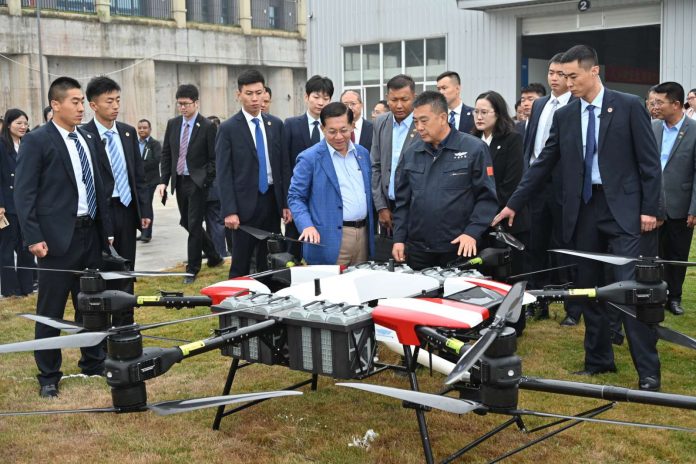Two suspected “suicide” drones struck Laiza, the Kachin Independence Army (KIA) headquarters located 72 miles (115 km) south of the Kachin State capital Myitkyina, on Feb. 25.
“We heard the two attacks [take place] but there were no casualties reported,” KIA spokesperson Naw Bu told the Voice of America (VOA), adding that it was the second “suicide” drone attack on Laiza since Jan. 24.
A “suicide” drone is an unmanned aerial vehicle (UAV) designed to carry explosives or other payloads and deliberately crash into a target and detonate upon impact.
A photo of one that allegedly struck Laiza was shared on social media by a local Kachin media outlet and a video was circulated on social media.
One also struck a middle school in Tagaylaung village of Bilin Township, Karen State, on Jan. 16. The school was destroyed but the Karen National Union (KNU) reported there were no casualties.
The aforementioned drones were first seen in video footage released by the Arakan Army (AA) during fighting with regime forces over the Western Regional Military Command (RMC) headquarters in Arakan (Rakhine) State in December.
The Free Burma Rangers, a humanitarian aid group operating in resistance-held areas of Myanmar, shared photos of the destroyed drone on social media.
“From the retrieval of part of that drone, it has the same configuration as a Chinese drone called the Sunflower 200 which itself is a copy of the Iranian Shahid 136 [drone] used across Ukraine [by Russia] over the last two years [of war],” Anthony Davis, a security analyst and consultant writer for Jane’s Defence Weekly, told DVB.
In 2024, the regime established a directorate specialized in drone warfare under its Ministry of Defence, and Davis said it is now calling 2025 “the year of the drone.”
The regime began deploying domestically manufactured drones to 12 of its 14 RMC. Two remain under the control of resistance forces since the AA seized the Western RMC in Ann Township of Arakan State on Dec. 20, and the Myanmar National Democratic Alliance Army (MNDAA) seized the Northeastern RMC in Lashio Township of northern Shan State on Aug. 3.
But Davis added that the regime manufactured drones are much smaller and technically less sophisticated than the Chinese version. The Sunflower 200 can carry a warhead around 40 kg.
Given the damage the regime drone inflicted in Karen State, the warhead was likely only 5 kg, according to Davis.
“The regime bought between 2,000 to 3,000 agricultural rotary drones, quadcopters and hexacopters, from China and developed the capacity to weaponize them with Chinese assistance at the Meiktila air base. The majority of the missions are carried out by [them],” said Davis.
The Karenni Nationalities Defence Force (KNDF) told DVB that resistance forces are unable to counter the regime’s use of suicide drones, since they can be deployed from the frontline.
“Obtaining, purchasing, or even accessing military-grade [drone] jamming devices is extremely difficult for us,” Maui Pho Thaike, the KNDF deputy commander, told DVB.
A member of the Kayan National Army (KNA) in Karenni State, named Ba Kone, told Al Jazeera English that military drones can fly at altitudes of 1,500 to 2,000 meters, beyond the reach of drone jammers.
Whether the increased use of drones will prove decisive on the battlefield remains debatable. The KIA reported regime drone attacks during the fight over control of Bhamo Township in Kachin State, which began on Dec. 4.
Still, KIA-led resistance forces successfully captured the regime’s Light Infantry Battalion (LIB) 236 on Feb. 20. The battle to seize the final regime outpost, the Military Operations Command (MOC) 21, in Bhamo continues.
“[The military] is using drones increasingly but against a multiplicity of forces – different [People’s Defence Forces] different [Ethnic Armed Groups] – all across the country so it’s very difficult to bring together to concentrate that degree of effectiveness,” added Davis.
A resistance group known as Federal Wings, which specialises in Unmanned Aerial Vehicle (UAV) and drone technology, announced that it is ready to provide technical assistance to any force opposing the 2021 military coup and wanting to utilize drones to attack regime forces.
Besides its own increasing use of drones, the regime has now deployed piloted motorized paragliders to attack resistance forces in Mandalay, Magway, Sagaing, Bago and Ayeyarwaddy regions. There have been around 25 recorded attacks since the beginning of the year, according to Davis.
“Motorized paragliders offer notable advantages in terms of low-cost production, mobility, simplicity of operation [typically by three-man teams], extended flight time, and a heavy payload weight of 15 kg or considerably more depending on wing size. Paragliders also effectively circumvent counter-drone jamming technology,” he wrote in his latest report for Jane’s Defence Weekly.
DVB contacted the National Unity Government (NUG) regarding the regime’s increasing use of drones and motorized paragliders in attacks against resistance forces. But received no response.



